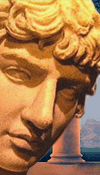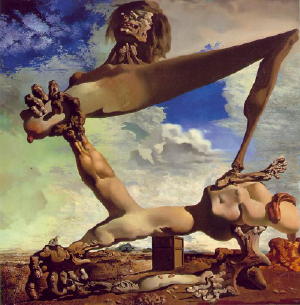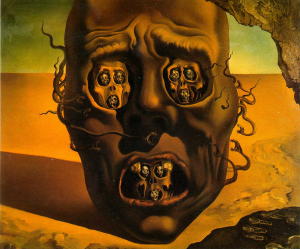





|
|
|
|
December 16, 2006
Being led by leading art
I know I'm going to sound biased here, but, hey. I am biased. I like the art of Salvador Dali, and I admit it. With that admission in mind, I want to return to Professor Fernando Tesón's fascinating post about political art: ...if one believes in moral-political truths, it seems natural to recommend that artists convey those truths in a way people can readily understand. Thanks to the emotional power of beauty, art can, at least sometimes, help noble ideals reach the general public. Many of these works have great artistic value (Picasso's Guernica, for example), and some of them have surely contributed to worthy causes.I've never cared for Diego Rivera's murals, for they leave little to the imagination. As for Guernica, it's widely considered the most important artistic statement against war in general.

The Spanish struggle is the fight of reaction against the people, against freedom. My whole life as an artist has been nothing more than a continuous struggle against reaction and the death of art. How could anybody think for a moment that I could be in agreement with reaction and death? ... In the panel on which I am working, which I shall call Guernica, and in all my recent works of art, I clearly express my abhorrence of the military caste which has sunk Spain in an ocean of pain and death.I know art is very personal, but as a painting, Guernica just doesn't say that much to me. Dali's "Soft Construction with Boiled Beans: Premonition of Civil War" is another matter.

The horror and revulsion are there along with the fascination. While surreal, the surrealism is oddly real, because civil war is grotesque, twisted, and unresolvable, yet it springs from man's nature (which is all of the above). It's his unflinching view of horror, of human evil versus human evil, and it's horrible despite the wishes of partisans who each wanted their human evil side declared "good."Unlike Guernica, it leaves a lot to the imagination, and I think it more properly expresses the horrors of war. It takes into account that war exists, that people are willing to kill each other, and that it isn't always obvious who is right and who is wrong. I feel less "led" by Dali, and whether anyone thinks he was a fascist or not (I don't think he was) is beside the point. Soft Construction represents the inevitability of Spain being torn apart, but I think it's more than that, as it poses fundamental, uncomfortable questions about man's nature, yet does not answer these questions or make judgments. Not that Dali failed to make it clear he was against war. In 1940, he even gave war a face:

"I was entering a period of rigor and asceticism which was going to dominate my style, my thoughts, and my tormented life. Spain on fire would light up this drama of the renaissance of aesthetics. Spain would serve as a holocaust to that post-war Europe tortured by ideological dramas, by moral and artistic anxieties.... At one feel swoop, from the middle of the Spanish cadaver, springs up. Half-devoured by vermin and ideological worms, the Iberian penis in erection, huge like a cathedral filled with the white dynamite of hatred. Bury and Unbury ! Disinter and Inter ! In order to unbury again ! Such was the charnel desire of the Civil War in that impatient Spain. One would see how she was capable of suffering; of making others suffer, of burying and unburying, of killing and resurrecting. In was necessary to scratch the earth to exhume tradition and to profane everything in order to be dazzled anew by all the treasures that the land was hiding in its entrails."I think we can all agree that war is bad. There's something I don't like about political art telling me which side I should be on in a particular war (or in a particular struggle), as I'd like to make that decision for myself. Whether Dali's art is political is a more difficult question. His art is much hated by political leftists, as is he. I liked the fact that he refused to be led by political types, just as his art refuses to lead people by the nose. posted by Eric on 12.16.06 at 06:30 PM
Comments
Thank you RH! Dali's Catholicism was a very important theme, even though he wasn't the greatest practitioner. His audience with the Pope reminded me of Orianna Fallaci's. Eric Scheie · December 17, 2006 01:38 PM Such art is political advertising. In fact a lot of art is political advertising. By politicians even. BTW it is very possibile that the Franco folks didn't do Guernica. I don't have a link at the moment, but I believe somebody did some research that indicated that no one bombed the town, but the leftists (for reasons I forget) may have set it on fire. Faux news is not a new phenomenon. M. Simon · December 17, 2006 07:30 PM Interesting. But what would that do to claims like this? http://www.theava.com/04/1124-fallujah.html
Where is the new Picasso who will offer a dramatic painting to help the 21st Century public understand that what the US Air Force just did to the people of Fallujah resembles what the Nazis did to Guernica? Eric Scheie · December 17, 2006 10:41 PM Nice article. Christo had nice things to say about art not being used for propaganda when he spoke here in Austin not too long ago. David Ohlerking II · December 18, 2006 09:04 AM Post a comment
You may use basic HTML for formatting.
|
|
December 2006
WORLD-WIDE CALENDAR
Search the Site
E-mail
Classics To Go
Archives
December 2006
November 2006 October 2006 September 2006 August 2006 July 2006 June 2006 May 2006 April 2006 March 2006 February 2006 January 2006 December 2005 November 2005 October 2005 September 2005 August 2005 July 2005 June 2005 May 2005 April 2005 March 2005 February 2005 January 2005 December 2004 November 2004 October 2004 September 2004 August 2004 July 2004 June 2004 May 2004 April 2004 March 2004 February 2004 January 2004 December 2003 November 2003 October 2003 September 2003 August 2003 July 2003 June 2003 May 2003 May 2002 See more archives here Old (Blogspot) archives
Recent Entries
• Abandoning all hope of government talking points?
• Zeroing in on guns that hate • Being led by leading art • Laughing at the failure of discourse? • Holiday Blogging • The right to be irrational? • I'm cool with the passion fashion • Climate change meltdown at the polls? • If you're wrong, then so is God? • Have a nice day, asshole!
Links
Site Credits
|
|
Thank you for giving me some insight into me, one of my favorite subjects upon which to be insightful.
I've always liked Dali. I never really knew why he was the one artist, alone among 20th Century artists, whose work I really liked. And you've hit upon the answer: the complete lack of a political agenda (although there is a religious (Catholic) in some of his later work). Given the relexive leftist extremism of most contemporary artists, the absence of an agenda strikes a chord with conservatives.
Most modern artists (meaning anyone since the World War I armistice) are too simple-minded, too banal in their politics, and too intellectually vacuous to have anything to say in matters of politics, war and peace, religion or any of the great issues of this era. Artists tend not to have much intelligence nowadays, a reversal from the entire run of recorded history that has left Western Civilization poorer and less interesting (and, Oh, how the modern artiste reflexively hate-hate-hates the idea of a "Western" civilization -- how droll!).
But back to Dali. His agenda was no agenda. And that's what a Catholic conservative boy like me can love about him.